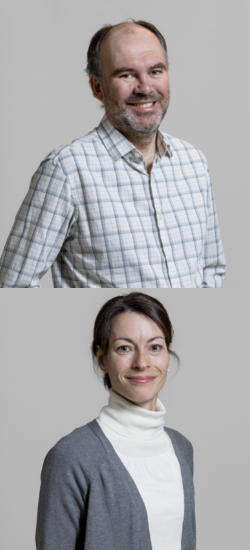For finding solutions to complex problems, such as those related to climate
Multidisciplinarity is often held up as the ideal research posture for finding solutions to complex problems, such as those related to climate. This is the approach that is employed by Michel Baraër, a Professor in the Construction Engineering Department at ÉTS and expert in the field of hydrology, in his work on the impacts of climate change on water resources originating from snow and ice.
Professor Baraër begins: “Our research team spends the winter with our feet in the snow”. His field research focuses primarily on improving the forecasting of winter floods. “We have observed that water will behave differently or change its route if the snowpack is covered with snow instead of a sheet of ice”, he explains.
However, there is no predictive strength in the results of these observations alone. That’s where Annie Poulin, a Professor in the Construction Engineering Department at ÉTS, comes in. Her collaborative involvement entails reconciling the observations from the field with data from modeling tools. According to Professor Poulin: “Our hydrology models enable us to better comprehend the physics of the processes, and therefore, to contribute to an improved understanding of the movement of water within the context of climate change.”
Annie Poulin and Michel Baraër characterize their collaboration as “quite natural”, because of their complementary fields of expertise. Michel Baraër continues: “The ultimate goal is to equip society and governments with tools and models that will help them understand and predict the behaviour of water, so that they can be better prepared for climate change. The input from the modeling makes our projections more reliable and more accurate.”
Decompartmentalization of research provides solutions
Michel Baraër believes that multidisciplinary research provides direct benefits for society. In fact, academic research granting organizations have shown a marked preference for these types of projects. His view is that, “as engineers, we can only be one link in the chain. We must work together with other disciplines to ensure a more complete understanding of these phenomena.”

By way of example, Professor Baraër mentions the research he carried out in Peru to explain the decrease in the quantity of water available for an agricultural population. “We didn’t observe any runoff from rivers fed by glaciers. The geographers were the ones who figured out, after speaking with the people, that when the mountain-dwelling population talk about water, they mean groundwater, and there was actually a decrease in resources from that perspective”, he recalls.
Annie Poulin is of the opinion that multidisciplinary research requires transparency and education in order to understand the professional language and culture of other collaborates. She clarifies: “Everyone may be facing the same challenges and problems, but they each understand and explain them based on different nuances and perspectives. It is important to be open and to listen carefully.”
Is multidisciplinarity the right approach for everyone?
The two researchers respond that multidisciplinarity will be of greater interest to their colleagues who have a global vision of their work and who have already forged relationships with colleagues from varied disciplines. Michel Baraër begins: “It can’t be forced! It starts with a productive discussion concerning a problem –maybe over a beer” – “and then a collaboration is formed to attempt to find a solution”, Annie Poulin concludes.
One thing is for sure: multidisciplinary projects rarely start from zero. “It requires a burning curiosity and a desire to get out and see what others are doing”, Michel Baraër claims. As a matter of fact, one of his collaborative experiences in the Yukon resulted in his working with individuals from Parks Canada, members of local First Nations and peers from the University of Calgary.
“Parks Canada took the lead on the conservation aspect, but maybe more importantly, we learned the First Nations perspective from two elders, who gathered the researchers together to tell to us how they live and how they are adapting to climate change. It was a very humbling and enlightening experience!”
The two colleagues from ÉTS also encourage their graduate and post-graduate students to join them in the field as part of their multidisciplinary teams. Annie Poulin explains: “They gain valuable experience from contributing to these types of collaborations and exchanges.” With these students already being introduced to how this approach works and the benefits it generates, multidisciplinarity is sure to increase in both quantity and quality.
Communications and Student Recruitment Service.
(514) 396-8800, ext. 7893



